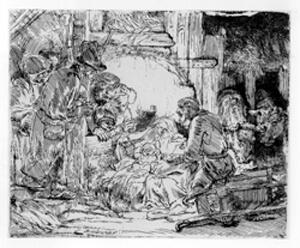The Stained Genealogy of Jesus
But when John saw many of the Pharisees and Sadducees coming to his baptism, he said to them, “Brood of vipers! Who warned you to flee from the wrath to come? Therefore bear fruits worthy of repentance, and do not think to say to yourselves, ‘We have Abraham as our father.’ For I say to you that God is able to raise up children to Abraham from these stones.” (Matthew 3:7-9)
December 25, Christmas Day, is approaching. As you know, Christmas is a worldwide holiday celebrating the birth of Jesus Christ. The New Testament describes in detail the genealogy of Jesus Christ at the very beginning of the book of Matthew. More than 40 names are listed in this genealogy, and most readers may find it tedious. Nevertheless, the New Testament lists the genealogy on its first page, as if insisting, “First, read the genealogy of Jesus Christ!”
Matthew begins, “The genealogy of Jesus Christ, the Son of David, the Son of Abraham.” This reference seems to stress that Jesus of Nazareth is the descendant of the revered father of faith, Abraham, whom God called “My friend, Abraham.” It also appears to be a proud proclamation that Jesus is the descendant of King David, who unified the Jewish kingdom for the first time.
Even before Jesus Christ was born, it was said that the Messiah (Christ), the wondrous person anointed with the Spirit of God, must come from the lineage of David. The prophet Isaiah said this, and in Jesus’ day, it was widely known. Yet, when we read through these verses, we find some disturbing and perplexing elements in the genealogy.
Four Questionable Women
In Judaism, it is customary to refer to the paternal lineage in one’s genealogy. For some reason, however, this genealogy mentions several women. It would be understandable if those maternal names included the most respected women, such as Sarah, wife of the pious Abraham, or Isaac’s wife, Rebekah. Indeed, we would say, “Like mother, like son.” However, the four women named seem inappropriate to be included in this genealogy.
It is written, “Judah begot Perez and Zerah by Tamar.” Tamar is a woman who disguised herself as a prostitute and deceived her father-in-law, Judah. Is it necessary to mention the name of the woman who conceived these children in such a deceptive manner?
Similarly, Boaz’s mother, Rahab, was a harlot of Jericho. Prior to the conquest of Jericho, she cunningly sheltered the scouts Joshua had dispatched. She was as brave a woman as a shrewd hostess of an inn or a madam of a brothel. One may wonder if it would have been better, even if true, not to mention that the maternal line of Jesus Christ traces back through a foreign prostitute.
Ruth’s name also is mentioned in the genealogy. Even though she was a Moabite, she believed in God and virtuously served her mother-in-law, Naomi. She followed Naomi all the way to Bethlehem in Judah. However, living among the Israelites, who valued their national pedigree, she had an inferior status.
Even worse was Solomon’s mother, the beautiful Bathsheba. The Bible says, “David the king begot Solomon by her who had been the wife of Uriah.” While Uriah was serving David’s army, David had an affair with Bathsheba. In order to take this married woman for himself, David schemed to have the loyal Uriah die on the battlefield. The reference to Solomon being born by the wife of Uriah may perplex the reader. The names of the four women are all infamous to one degree or another.
As for the Virgin Mary, Scripture explicitly states that she was “found with child of the Holy Spirit.”Now the birth of Jesus Christ was as follows: After His mother Mary was betrothed to Joseph, before they came together, she was found with child of the Holy Spirit. (Matthew 1:18)
Like a White Lotus Blooming in a Muddy Pond
Generally, birth tales of distinguished figures and saints are written to evoke respect. For example, the Buddhist monk Nichiren was the son of an impoverished fisherman, but it is said that his mother conceived him after dreaming of being impregnated with the glow of the sunrise from the Pacific Ocean. Similarly, on the morning of his birth, there was said to be an exquisite spectacle of white lotuses blooming across the ocean and clear waters welling up in the garden. On the other hand, the genealogy of Christ may seem as if written with malicious intent. Believers might think it should have been written in a less explicit manner. Yet this is the gospel, and herein lies what makes the gospel the gospel.
Jesus Christ was born an illegitimate child from an infamous lineage. But just as a dewy lotus blooms out of a stale, muddy pond, Christ was born out of a quagmire of sins. The Virgin Mary conceived by the Holy Spirit and gave birth to Jesus. Even though the tale of the Child may have been wrought with ill fame, God even defied Mendel’s heredity law in order to bring about the birth of the Son of God, Jesus Christ, among humankind by the power of the Holy Spirit. The Bible is written as it is to convey this very point.

John the Baptist said to the unfaithful, “Brood of vipers! . . . Do not think to say to yourselves, ‘We have Abraham as our father.’ For I say to you that God is able to raise up children to Abraham from these stones” (Matthew 3:7-9). In this way, he disregarded the lineage of these people. How consoling his words are! They are a gospel of hope. The revered Christian Toyohiko Kagawa was, similarly, an illegitimate child.
However stained we may be with sins, and even if we are like stones groaning under the fate of life, once we receive God’s breath and are baptized in the Holy Spirit, we are instantly changed into children of God. This is the gospel. This is what Jesus Christ’s twelve apostles and many others experienced, including St. Paul. Once they received the Holy Spirit, they completely changed and became saints of God.
God’s Power Can Change Fate
When we read the tales of great men and heroes, we are impressed by their greatness; and yet when we in turn look at ourselves, we are overwhelmed by inferiority complexes and cry over our shortcomings. However, the birth of Jesus Christ was worse than ours—indeed, it was pitiful. Without a room in an inn to stay, He was born on the straw in a stable. As an uneducated country carpenter, Jesus had nowhere to lay His head during His journey of ministry. After fleeing from persecutions, He was finally crucified in Jerusalem. Forsaken by all, His life seemed drenched with defeat. Even so, He is the Son of God, who today is worshiped throughout the world as Jesus Christ. The sacred Son of God was born from a stained genealogy. If this is not the gospel, then what is it?
Those of you who grieve over your own stained genealogy, please turn to the Bible. Jesus’ genealogy dared to mention Tamar, who knowingly committed a deceptive act; Rahab, who sold herself as a harlot; Ruth, who was bereft of her husband and cried in a foreign land; and Bathsheba, who married David, the murderer of her husband Uriah.
They did not have perfectly blessed marital lives as women; nevertheless, God raised Jesus as Christ from the lineage of these sorrowful women. The tears they shed in distress and sorrow surely did not end in vain.
You must not be tormented by your past or cry for your fate and give up. Those of you who lament your cursed family history and cry over your stained past don’t need to wallow in regret, no matter how embarrassed and ashamed you are. God’s power can change our fate. Once inspired and empowered by God’s Holy Spirit, even those who lie like stones by the roadside can restore their lives as children of God. Just as a caterpillar transforms itself into a butterfly and flies into the sky, we, too, can experience a metamorphosis. The stained genealogy of Jesus Christ is full of unlimited hope. May you, too, receive the overflowing life of Christ and wholeheartedly live in faith, inspired by joy and hope.
Ikuro Teshima
(1972)


